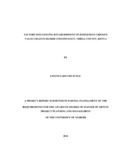| dc.description.abstract | The value chain approach embraces the full range of activities which are required to
bring a product or service from conception, through the intermediary phases of
production, delivery to final consumers, and final disposal after use. Traditionally
extension agents have concentrated their efforts on technology transfer that targeted
production aspects of a poultry and ignored other factors of the value chain. Most farmers
specialize in production and may be excluded from decision making about issues that
affect them outside their farms. There exists a knowledge gap of what potential there is
for income generation and employment creation in the indigenous chicken value chain.
Despite their hard work farmers continue to have low incomes resulting into low living
standards. There are several factors that influence the Indigenous Chicken Value Chain.
This study aimed to explore how factors of credit, disease control, extension services and
market infrastructure influences the establishment of the indigenous chicken value chain
in Hamisi Constituency, Vihiga County. The study employed a descriptive survey
research design. The target population consisted of 302 farmers who were members of 23
chicken farmers’ groups, 13 Agrovet attendants, 15 Indigenous Chicken Traders and one
agricultural extension officer assigned to the study area. A random sample of 169 farmers
was drawn from the 302 farmers using simple random sampling, with the guide of
research randomizer generator. All the Agrovet attendants, extension service provider and
IC traders were included in the study, as their number was small to sample. The
reliability coefficient for the farmers’ instrument obtained was 0.811(see appendix I).
This was considered adequate for the study. Data was analyzed using frequencies, means,
median, mode, variance and correlations. Results from the study indicated that control of
NCD had significant influence (r=0.588) on the establishment of the indigenous chicken
value chain in Hamisi Constituency. The correlation between the establishment of ICVC
and Extension services was of r=0.33, Market access at r=0.117 and that with Credit
access was low at r=0.016. Market facilities for slaughter, cold storage and dedicated sell
outlets for birds were completely lacking in all the major market centers in the study area.
Local authorities in consultation with relevant technical departments should invest in
market infrastructure that will enhance sales of chicken and other chicken products.
Extension Officers should be increased from the current 1 to at least 7 in order to
adequately meet the demand of the services. They should embrace the value chain
approach and provide information on credit. Credit providers should educate the masses
on accessibility and types of credit they offer, being clear on terms and conditions so as
to eliminate the negative perception on loans. The thermal stable NCD vaccine should be
made available in rural areas where electricity is not available. Local leaders should
educate and encourage farmers to commercialize indigenous chicken production as a
means of poverty reduction. | en_US |

